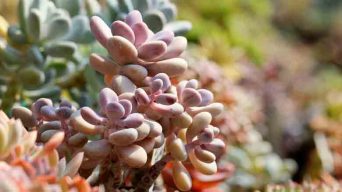Calathea plants, also known as prayer plants, are becoming increasingly popular as houseplants for their lush, green foliage and beautiful texture. Unfortunately, calatheas can become leggy over time and lose their bushy appearance.
A lush and full calathea isn’t hard to achieve if you know how! Proper care and pruning will keep your prayer plant looking healthy and vibrant.
Here you’ll find how to make your calathea bushy and how to keep it looking lush:
Understanding Calathea Growth Habits and Needs
Calathea plants are native to tropical and subtropical regions and prefer warm, humid environments. They thrive in bright indirect light and like their soil kept consistently moist during growth season.
To properly care for your prayer plant and promote lush growth, you’ll need to provide proper lighting, watering, humidity, and fertilization.
Proper Lighting
Ensuring your calathea gets adequate lighting is critical for lush, bushy growth.
While direct sunlight can be too intense and cause burning on the leaves, calatheas also don’t like to sit in complete darkness. Low light conditions can cause the calathea to become leggy, with long stems and sparse foliage.
The ideal light situation for a calathea is bright indirect light. This means that the plant should receive bright light but no direct sunlight. Providing indirect sunlight in a home setting can be tricky, so here are some tips:
Position Your Plant Near a Window
If you have a bright window that doesn’t receive direct sunlight throughout the day, this is an ideal spot for your calathea. East- or west-facing windows are often the best choice and will give your calathea the light it needs.
The brighter the indirect light that your plant receives, the bushier growth it will have.
Rotate Your Plant Regularly
It’s important to rotate your calathea every few days so that all sides of the plant are exposed to light evenly and avoid one-sided stretching. This will help keep your calathea compact and bushy.
Proper Watering
Proper watering is essential for keeping a calathea plant looking lush and bushy. For optimal results, use lukewarm water to avoid shocking the roots. Water plants thoroughly until excess liquid comes out of the drainage holes in the bottom of the pot. Let the potting soil mix dry out between watering sessions to make sure it doesn’t become oversaturated.
When watering calathea plants, there are two common mistakes to avoid.
Overwatering
An overwatered calathea plant will develop yellow and wilted leaves and shallow root growth.
Overwatering is often the result of a too-frequent watering schedule or a pot that doesn’t have adequate drainage.
To prevent this from happening, feel the soil before each watering session and only water it if it’s dry to the touch. Additionally, use pots with a drainage hole so excess liquid can escape.
Underwatering
An underwatered calathea will have brown and crispy leaves. To prevent this, water the plant regularly and monitor how quickly the soil dries out – if it’s drying out too quickly, increase the watering frequency.
To keep your calathea healthy and bushy, develop a regular watering schedule that works for your plant. Pay attention to how fast the potting soil dries out and how the plant responds to changes in watering frequency.
Proper Humidity
Calatheas thrive in a high humidity environment, with the ideal humidity level ranging between 40-60%. Maintaining this humidity level can be difficult if your home is not humid. Fortunately, there are several ways to increase the humidity of your calathea plants.
The most straightforward method of increasing the humidity is using a humidifier in the room. This is an excellent solution to ensure your plants get the best possible environment.
Another option is grouping several calatheas and misting them with water every few days, which will also help increase the humidity around them. Additionally, placing a tray of pebbles filled with water near the plants will help create a humid environment.
Proper Fertilization
Calatheas need regular fertilization to remain healthy and bushy. The ideal fertilizer for calathea plants is formulated with a balanced nitrogen-phosphorus-potassium ratio, such as 10-10-10.
A diluted liquid fertilizer should be applied every two to three weeks during the growing season (spring through fall). In the winter, fertilizing should be reduced to once a month. When applying the fertilizer, distribute it evenly around the base of the plant and avoid getting it on the leaves.
By following these steps and providing your calathea with proper humidity and fertilization, you can ensure that your plants are healthy and bushy!
Pruning Techniques to Make Calatheas Bushy
Pruning is an effective way to keep calathea plants bushy and full. It helps stimulate new growth, encourages bushier plants, and prevents leggy or overgrown stems.
There are two main pruning techniques for calatheas: pinching and cutting back.
When pruning calatheas, it’s important to remember that they don’t require a lot of pruning. Prune sparingly, as too much can stunt the plant’s growth. Pinching and cutting back should be done regularly and carefully to maintain a full, bushy look while encouraging new growth.
Proper pruning is an effective way to keep calathea plants looking their best.
Pinching Back
Pinching calatheas is a way of pruning that encourages new growth and creates a fuller, bushier plant. It involves lightly pinching off the tips of stems at their growing points. This should be done regularly to encourage new growth and maintain a full, bushy appearance.
It’s best to pinch back calatheas at least once a month and more often during the growing season. When pinching back, only remove each stem’s top 1-2 inches (2.5 – 5 cm) for best results.
Pinching is an easy and effective way to shape the plant and create a fuller look.
Cutting Back
Cutting back is another pruning technique used for calatheas. This involves cutting stems back to their base or above and removing large plant sections. Cutting back can be done periodically throughout the year but only when necessary. When pruning, always use clean, sharp shears and cut stems above their nodes so new growth can emerge from the base.
To prune property, aim to remove about 1/3 of the total length of each stem. Be sure to cut stems back in even sections, avoiding random or complete trimming, as this can cause plant stress.
Overall, pruning is an effective way to keep calathea plants bushy and full.
You can encourage new growth and maintain a fuller appearance by pinching back and cutting back in moderation.
Regular pruning is essential for plant health, yet caution should be taken as excessive or improper pruning could harm plants. Proper pruning techniques can keep your calathea plants looking their best all year round.
Common Problems and Solutions
Some problems can arise when growing calathea plants and affect how bushy and full the plants are. To ensure calatheas remain in optimal condition, it is imperative to be proactive about addressing any potential problems.
Pests
Calatheas can be susceptible to pests such as mealybugs, aphids, and spider mites. These pests can affect the plant’s growth and cause damage to the stems and leaves.
To make sure that your calatheas remain healthy, regularly check them for any indications of pests and take action immediately if you discover anything.
Insecticidal soaps, horticultural oils, or other insecticides can treat any infestations.
Diseases
Calathea plants are also vulnerable to fungal and bacterial diseases. These can affect how bushy and full the plants are and how healthy they look.
It’s essential to recognize any signs of disease early on and address them quickly. Treating with fungicides or bactericides can help prevent further damage from occurring and keep your prayer plants looking their best.
Some common diseases affecting calatheas include leaf spot, powdery mildew, and root rot.
Troubleshooting Tips for Lack of Growth or Bushiness
If your calathea isn’t as bushy and full as you’d like it to be, some troubleshooting tips might help.
- Check the amount of light the plant is receiving. Calatheas do best in bright indirect sunlight and can become leggy or sparse without enough light. Move it to a brighter spot, but not right in front of a window.
- Ensure the soil is moist, not overly wet or dry. Calatheas need consistently moist soil to thrive and bush out. Check with your finger how wet the top 2 inches of soil are before watering again.
- Prune regularly. Pruning your prayer plant helps encourage growth by removing any thin or weak stems.
- Fertilize monthly during the growing season with a balanced liquid fertilizer, diluting it to half the recommended strength. Fertilizing your calatheas will promote lush, full growth and make them look vibrant.
- Avoid drafts and sudden temperature changes. To maintain a healthy, happy Calathea plant, you’ll want to avoid sudden temperature changes and drafts. Keep your potted friend away from air vents or doors as much as possible for optimal growth.
By following these tips, you can achieve fuller and healthier prayer plants quickly!
Final Thoughts
Growing calathea plants can be a rewarding experience, and with the proper care, your plant will become bushier in no time.
With proper light, humidity, and watering, as well as regular pruning and fertilizing, your calathea can thrive and bring its unique beauty to any room in your home!
So dare to experiment and savor the journey of creating a fuller calathea plant. Best of luck!







